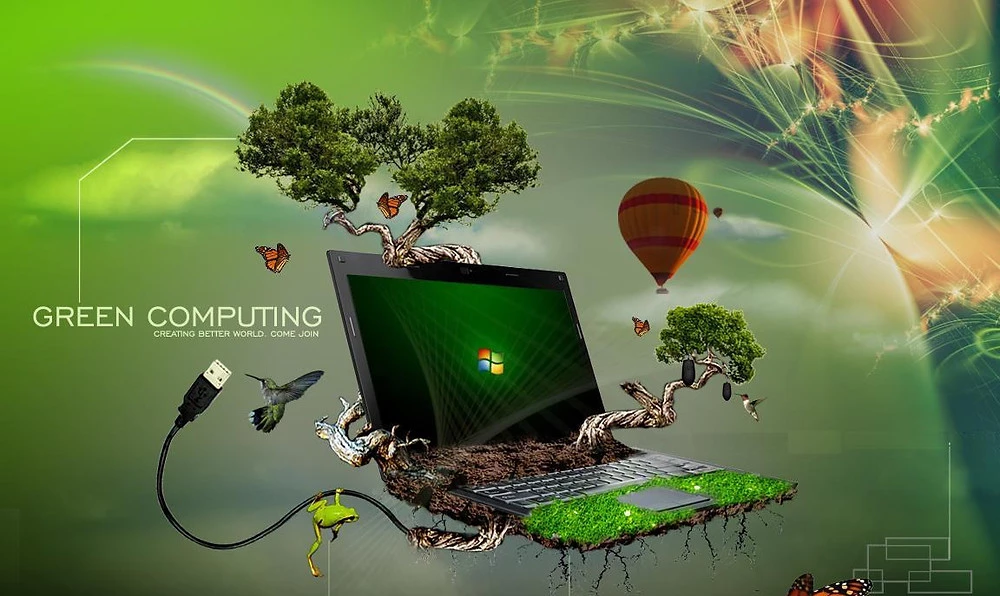Do you want to make your computer usage more eco-friendly? Here are some tips and strategies to get you started! Green computing doesn’t have to be difficult or expensive and can make a real difference in reducing your environmental impact. Read on for more information.

What is Green Computing?
Green computing is the practice of using computers and other electronic devices in an environmentally responsible way. This means reducing energy consumption, minimizing waste, and using environmentally friendly materials. Green computing can also involve recycling old computers and other electronics.
Example of Green Computing
This includes everything from conserving energy efficiency to recycling old equipment. Here are a few examples of green computing in action:
1. Use power-saving settings on your computer
Most green computers have electrical power-saving features built-in, such as the ability to dim the screen or go into standby mode when not in use. By taking advantage of these features, you can reduce energy consumption and lower your electric bill. The savings are significant; the average annual energy consumption for U.S. office buildings is over 23-kilowatt hours per square foot, with heat, air conditioning, and lighting accounting for 70% of all energy consumed.
2. Purchase Energy Star certified equipment
When shopping for new computers and other electronics, look for the Energy Star label. Energy Star products are designed to be more energy-efficient than standard models, so they’ll help you save money and conserve resources.
Who invented Green Computing?

The precise origins of “green computing” are a little hard to pin down, but the concept has been around for at least a couple of decades.
The term itself seems to have first gained traction in the early 2000s, though it’s likely that people were thinking about ways to make computing systems more environment-friendly long before that.
History of Green Computing

The term “green computing” refers to the environmentally responsible use of computer networks and related resources. This includes properly disposing of outdated or end-of-life hardware and using energy-efficient laptops, PCs, printers, and other computing devices. Green disposal practices to protect the environment, green manufacturing, making efficient use of resources, and efficient power management to save electricity.
The history of green computing can be traced back to the early days of personal computing in the 1970s. One of the first conservation efforts was Heathkit’s H8 (“Heath Green”) computer, which was designed to be as energy-efficient as possible.
In the 1980s, Philips released a number of “Green Peripherals,” including power-saving monitors and printers. Green computing practices came into prominence in 1992 when the Environmental Protection Agency (EPA) launched the Energy Star program. Green computing is also known as green information technology (green IT). In 1992, Apple ran a now-famous ad campaign called “Think Green,” which urged consumers to recycle their used energy efficient computers and peripherals.
This was followed by a number of other companies launching their own recycling programs. In the 2000s, green computing became more mainstream, with organizations like Greenpeace and the Climate Group promoting the adoption of energy-efficient devices and practices.
In 2007, the United Nations released its first set of guidelines for “Climate-Neutral Computing“.
In recent years, there have been a number of high-profile initiatives to promote eco-friendly technology, including the launch of the “Green 500” list of the world’s most energy-efficient supercomputers and the development of the “Carbon Footprint Calculator” for measuring the emissions of individual devices.
Looking to the future, it’s clear that green computing will continue to be an important part of our efforts to build a sustainable future. With the right policies and practices in place, we can all do our part to reduce our impact on the planet. Equipment recycling, reduction of paper usage, virtualization, cloud computing, power management, and green manufacturing are the key initiatives toward Green Computing.
The Goal of Green Computing

Green computing refers to the environmentally responsible use of computers and related resources. This includes practices like recycling and reducing energy consumption. Other than that renewable energy efficiency resources exist such as nuclear energy, fuel, wind energy, coal, natural gas, and biological fuel are examples of green renewable energy.
The goal of green computing is to minimize the environmental impact of computing while still meeting all of our needs for information and communication. In other words, we want to be able to enjoy all the benefits of modern green technology without harming the planet or using up resources that future generations will need.
Types of Green Computing
Reducing Energy Consumption
There are many types of green computing, but the most common is reducing energy use. This can be done in a number of ways, from using energy-efficient hardware to simply turning off devices when they’re not in use.
Solar Power System:
Solar power is a great way to reduce your energy consumption and your carbon footprint. Solar panels can be used to generate electricity for your home or office.
Wind Power System:
Another option for reducing your energy consumption is to install a wind power system. Wind turbines can be used to generate electricity, and they can also be used to create mechanical energy that can be used to power pumps or other digital devices.
Geothermal Power System:
A geothermal power system uses the heat from the Earth’s core to generate electricity. This type of system is very efficient and has a very small environmental impact.
Recycled or Recyclable Materials:
Another type of green computing is using recycled or recyclable materials for new hardware or rebuilding existing hardware. And lastly, ‘virtualization’ is becoming increasingly popular as it doesn’t require any physical resources at all everything is done via software.
The importance of Green Computing
- Green computing is the environmentally responsible use of computing resources.
- It encompasses the practices involved in designing, deploying, managing, and recycling computer hardware and software in an efficient manner that conserves energy and reduces waste.
What is included in a green computing strategy?
A green computing strategy includes the following basic steps:
1) Reduce the number of devices and products used
2) Use more efficient devices and products that consume less energy
3) Recycle or properly dispose of electronic waste. (Repurposing existing equipment)
4) Educate employees about the benefits of green computing and how they can help increase efficiency in their work routines.
5) Educate management on the importance of reducing environmental impact and implementing green policies.
6) Advocate for changes in government regulations that would promote greener technology practices.
Where is Green Computing Used?
Green computing is used in many different ways to help reduce the environmental impact of computing.
Energy Efficient Devices:
One way is by using more energy-efficient devices and components. This can help reduce electricity consumption and save money on power bills. Additionally, recycling and reuse of materials can help keep electronic waste out of landfills.
Software Programs:
Another way green computing is used is through careful selection of the software programs installed on computers. That’s because some software programs use more resources than others. By eliminating unused programs and only installing what’s needed, it’s possible to free up valuable resources, like memory and processing power. Additionally, some types of software are designed to be more environmentally friendly than others.
Cloud Computing:
A third way green computing is used is by utilizing cloud-based services. This can help reduce the need for physical resources, like servers and storage devices. Additionally, it can help save energy by allowing users to access information and applications remotely, without having to power up a computer.
How can you contribute to green computing?
There are a number of ways to contribute to green computing, from making small changes in your everyday habits to advocating for larger policy changes. Some easy ways to get started include:
– Turning off electronic systems when you’re not using them
– Unplugging chargers when they’re not in use
– Using a laptop instead of a desktop computers
– Installing a smart thermostat that can save energy when you’re not home
– Shopping for electronics and appliances that have an Energy Star rating
How do achieve green computing Aims?
Green computing is a way to minimize the environmental impact of information technology (IT). The three key aspects of green computing are energy conservation, data center efficiency, and end-of-life management.
- Energy Conservation: Use Energy Star logo equipment and unplug electronic equipment when not in use.
- Data Center Efficiency: Make sure your computer is using the correct power supply and configure it for maximum performance.
- End-of-Life Management: Recycle or appropriately dispose of existing equipment.
Benefits of Green Computing
It is estimated that out of $250 billion per year spent on powering computers worldwide only about 15% of that power is spent computing, the rest is wasted idling (i.e. consumed by computers that are not in use but still turned ON). Green computing, the practice of optimizing the use of computer resources, has been a growing trend in the industry for a few years now. And with good reason, green computing can offer businesses and organizations a number of benefits, including:
- Decreased energy consumption and energy costs, leading to decreased emissions and environmental impact.
- Improved efficiency and productivity as a result of using less energy.
- Reduced wear and tear on equipment, translating into extended hardware life.
- Fewer hardware replacements and waste.
- Improved overall sustainability.
Conclusion
This can be done through a variety of methods, from making sure your devices are energy-efficient and selecting environmentally responsible hardware, to recycling procedures and composting old tech gear.
From the different types of green computing to how to achieve it for your business or yourself, we have covered it all in this post. By the midpoint of 2022, it’s time to reflect on our carbon footprints and take steps toward more sustainable practices such as green computing. We’d love to hear about how you plan to incorporate green computing into your life or work in the future!





